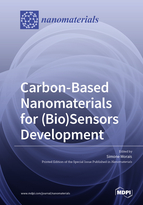Carbon-Based Nanomaterials for (Bio)Sensors Development
A special issue of Nanomaterials (ISSN 2079-4991). This special issue belongs to the section "Nanoelectronics, Nanosensors and Devices".
Deadline for manuscript submissions: closed (10 June 2020) | Viewed by 68180
Special Issue Editor
Interests: (bio)sensors; application of functional nanostructured materials; green technologies; new methodologies for (electro)analysis; environmental chemistry; monitoring/biomonitoring
Special Issues, Collections and Topics in MDPI journals
Special Issue Information
Dear Colleagues,
Carbon-based nanomaterials have been increasingly used in sensors and biosensors design due to their advantageous intrinsic properties that include but are not limited to high electrical and thermal conductivity, chemical stability, optical properties, large specific surface, biocompatibility, and easy functionalization. The most commonly applied carbonaceous nanomaterials are carbon nanotubes (single or multiwalled nanotubes) and graphene, but promising data have been also reported for (bio)sensors based on carbon quantum dots and fullerene, among others. The incorporation of carbon-based nanomaterials, independently of the detection scheme and developed platform type (mechanical, thermal, optical, magnetic, chemical, and biological), has a major beneficial effect on the (bio)sensor sensitivity, specificity, and overall performance. As a consequence, carbon-based nanomaterials have been promoting a revolution in the field of (bio)sensors with the development of increasingly sensitive devices.
Thus, the aim of this Special Issue is to publish and disseminate original research data, review articles, communications, and short notes that focus on new (experimental or theoretical) advances, challenges, and outlooks concerning preparation, characterization, and application of carbon-based nanomaterials for (bio)sensors development.
Prof. Dr. Simone Morais
Guest Editor
Manuscript Submission Information
Manuscripts should be submitted online at www.mdpi.com by registering and logging in to this website. Once you are registered, click here to go to the submission form. Manuscripts can be submitted until the deadline. All submissions that pass pre-check are peer-reviewed. Accepted papers will be published continuously in the journal (as soon as accepted) and will be listed together on the special issue website. Research articles, review articles as well as short communications are invited. For planned papers, a title and short abstract (about 100 words) can be sent to the Editorial Office for announcement on this website.
Submitted manuscripts should not have been published previously, nor be under consideration for publication elsewhere (except conference proceedings papers). All manuscripts are thoroughly refereed through a single-blind peer-review process. A guide for authors and other relevant information for submission of manuscripts is available on the Instructions for Authors page. Nanomaterials is an international peer-reviewed open access semimonthly journal published by MDPI.
Please visit the Instructions for Authors page before submitting a manuscript. The Article Processing Charge (APC) for publication in this open access journal is 2900 CHF (Swiss Francs). Submitted papers should be well formatted and use good English. Authors may use MDPI's English editing service prior to publication or during author revisions.
Keywords
- Biosensors
- Nanoprobes, electronic noses, and sensors
- Graphene
- Carbon nanotubes
- Carbon quantum dots
- Fullerene
- Nanodiamonds
- Nanohybrids and nanocomposites
- Coatings and thin films
- Synthesis
- Characterization
- Functionalization
- Applications







